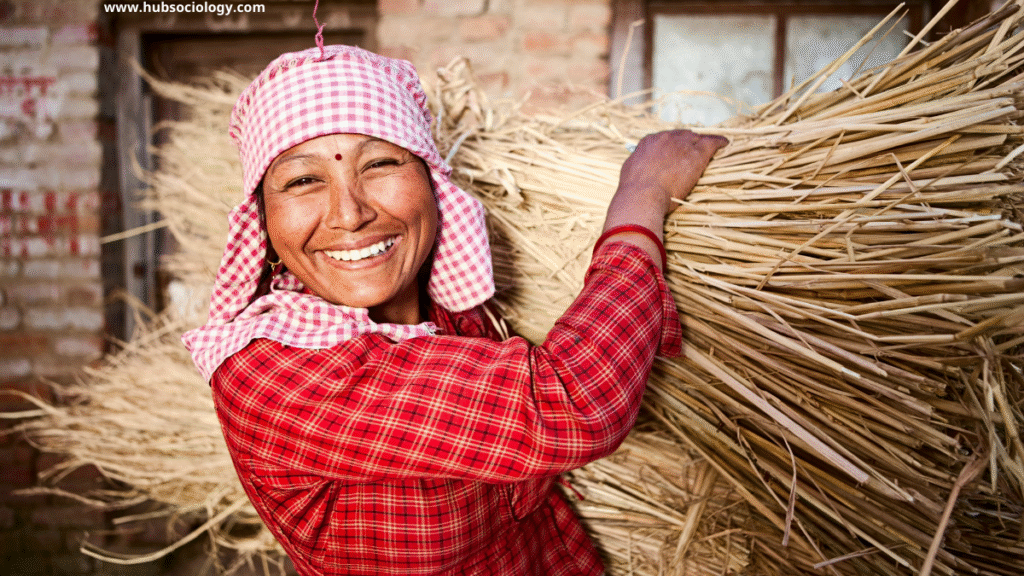Introduction on Gender and Social Stratification
Social stratification refers to the hierarchical arrangement of individuals and groups in society based on unequal distribution of resources, opportunities, and power. Traditionally, sociologists have examined stratification through class, caste, race, and ethnicity. However, gender has increasingly been recognized as a crucial dimension of stratification because it deeply influences individuals’ social roles, access to resources, and life chances. Gender is not simply a biological category but a social construct that shapes and is shaped by cultural norms, institutions, and structures of power.
In the sociological study of gender and social stratification, scholars focus on how gender-based inequalities are created, maintained, and challenged within societies.

Table of Contents
Understanding Gender as a Social Category
Gender differs from sex in sociology. While sex refers to biological differences, gender represents socially constructed roles, behaviors, and expectations attached to being male or female. Stratification based on gender thus results from the cultural meanings assigned to masculinity and femininity and the institutional arrangements that reinforce them. For example, the idea that men are “breadwinners” and women are “caregivers” has historically structured economic opportunities and political power in ways that favor men.
The social construction of gender is not static. It changes over time and across societies, but inequalities between men and women have been a persistent feature of most social systems. Gender interacts with other dimensions of stratification—such as class, caste, and race—producing intersecting forms of oppression or privilege.
Theoretical Perspectives on Gender Stratification
- Functionalist Perspective
Functionalists argue that gender roles have historically contributed to the stability of society. For example, Talcott Parsons emphasized the division of labor in families, where men perform instrumental roles (economic provision) and women perform expressive roles (emotional care). While functionalism explains how gender roles are institutionalized, critics argue that it justifies inequalities by portraying them as “natural” or beneficial. - Conflict Perspective
Conflict theorists, inspired by Marx, view gender inequality as a result of power struggles. Friedrich Engels, in The Origin of the Family, Private Property and the State, argued that women’s subordination emerged with the rise of private property and inheritance systems, which privileged male dominance. Contemporary conflict theorists stress that men, as a group, have historically maintained control over economic and political resources, perpetuating women’s marginalization. - Feminist Perspectives
Feminist theories directly address gender stratification. Liberal feminists emphasize equal opportunities in education, work, and politics. Radical feminists highlight patriarchy as a system of male domination embedded in all social institutions. Socialist feminists combine Marxist and feminist insights, linking women’s oppression to both capitalism and patriarchy. Intersectional feminism, influenced by scholars like Kimberlé Crenshaw, stresses how gender inequality intersects with race, class, and other identities. - Symbolic Interactionist Perspective
Interactionists focus on everyday practices that reproduce gender inequalities. Gender is “performed” through language, dress, and interactions, reinforcing societal expectations. For example, teachers may unconsciously encourage boys to be assertive and girls to be compliant, thereby shaping future opportunities.
Gender and Dimensions of Social Stratification

- Economic Stratification
One of the clearest areas of gender inequality is the economy. Women often face wage gaps, occupational segregation, and limited access to leadership positions. Despite progress, women worldwide earn less than men for the same work. In many developing societies, women’s labor is undervalued or unpaid, especially in household and caregiving roles. The “glass ceiling” phenomenon prevents women from advancing to top positions, while the “sticky floor” keeps them in low-wage jobs. - Educational Stratification
Education is a key avenue for upward mobility, yet gender disparities persist. In some societies, girls face barriers to schooling due to cultural norms, poverty, or early marriage. Even when girls achieve high levels of education, gender stereotypes can channel them into traditionally “feminine” fields such as nursing or teaching rather than science or engineering. Access to education has improved globally, but unequal outcomes still reflect deep-rooted biases. - Political Stratification
Politics remains a male-dominated sphere. Although women have made strides in representation, they are still underrepresented in legislatures, cabinets, and leadership positions. Structural barriers such as patriarchal party systems, financial constraints, and gender stereotypes restrict women’s participation. Countries like India introduced women’s reservation in local governance, which has increased women’s visibility, yet decision-making power often remains constrained. - Social and Cultural Stratification
Gender roles are deeply tied to cultural expectations and religious traditions. Women may face restrictions on mobility, dress, and public presence. Patriarchal ideologies often present these restrictions as “protection” or “tradition,” masking their oppressive character. In many societies, practices such as dowry, child marriage, and honor killings reflect extreme forms of gender stratification. - Family and Kinship Systems
The family is a central site where gender stratification is reproduced. In patriarchal kinship systems, men control property, decision-making, and lineage. Women’s identities are often defined in relation to fathers, husbands, or sons. Domestic labor, though essential, is undervalued and unpaid, reinforcing economic dependence.
Gender Stratification in Global and Indian Contexts
Globally, gender stratification takes different forms. In advanced capitalist societies, women may enjoy legal equality but still face wage gaps and glass ceilings. In many developing societies, women confront both cultural restrictions and economic marginalization. International organizations like the United Nations advocate gender equality as part of sustainable development goals, but progress remains uneven.
In India, gender stratification is shaped by intersections of caste, class, and religion. Patriarchal traditions persist, influencing inheritance laws, educational access, and labor participation. Female labor force participation in India remains among the lowest globally. Practices like dowry and gender-selective abortions reflect entrenched inequalities. At the same time, women’s movements and feminist activism in India have challenged patriarchy, leading to significant legal reforms such as laws against domestic violence and workplace harassment.
Gender, Intersectionality and Stratification
A crucial sociological insight is that gender stratification cannot be studied in isolation. Intersectionality shows how gender interacts with class, caste, race, and sexuality. For instance, while upper-class women may access education and employment, lower-class women may remain trapped in exploitative labor. Dalit women in India face “triple oppression” due to caste, class, and gender hierarchies. Similarly, Black women in the U.S. or migrant women in Europe encounter compounded inequalities that differ from those faced by white women or men of their own communities.
Social Change and Resistance on Gender and Social Stratification
Gender stratification is not immutable. Feminist movements worldwide have challenged patriarchal systems, demanding equal rights, reproductive freedom, and protection from violence. Social movements have also redefined masculinity, questioning rigid gender norms. Legal frameworks—such as equal pay laws, affirmative action, and family-friendly policies—have attempted to reduce gender inequalities. Education and media have played a significant role in raising awareness, though cultural resistance often persists.
Technological changes also impact gender stratification. Digital platforms provide opportunities for women’s empowerment, entrepreneurship, and activism, but they also expose women to new forms of online harassment. The COVID-19 pandemic highlighted structural gender inequalities, as women disproportionately shouldered unpaid care work, yet it also created opportunities for reevaluating work-life balance and gender roles.
Conclusion on Gender and Social Stratification
Gender and social stratification are deeply interlinked, shaping individuals’ life chances and the broader organization of society. Gender is not merely a personal identity but a structural principle that distributes power, resources, and opportunities unequally. Through economic, educational, political, and cultural dimensions, gender stratification limits women’s agency while privileging men, though the degree and form vary across societies. Sociological perspectives—from functionalism to feminism—help us understand both the persistence and transformation of these inequalities.

Recognizing intersectionality reveals that gender-based inequalities intersect with other forms of oppression, making solutions complex but necessary. The struggle for gender equality continues globally, requiring not only legal reforms but also cultural change and restructuring of social institutions. By addressing gender stratification, societies can move toward greater justice, inclusiveness, and human development.
Do you like this this Article ? You Can follow as on :-
Facebook – https://www.facebook.com/hubsociology
Whatsapp Channel – https://whatsapp.com/channel/0029Vb6D8vGKWEKpJpu5QP0O
Gmail – hubsociology@gmail.com
Exam-style questions on Gender and Social Stratification
5 Marks Questions on Gender and Social Stratification
- Define gender stratification in sociology.
- Distinguish between sex and gender with examples.
- What is the “glass ceiling” in relation to gender inequality?
- Explain the concept of “patriarchy.”
- Mention two ways in which family reinforces gender stratification.
10 Marks Questions on Gender and Social Stratification
- Discuss the functionalist perspective on gender roles and stratification.
- How does education contribute to both reducing and reproducing gender inequalities?
- Explain the significance of intersectionality in understanding gender stratification.
- Examine the status of women in the Indian social stratification system with examples.
- How do feminist theories challenge traditional explanations of gender inequality?
15 Marks Questions on Gender and Social Stratification
- Critically analyze the relationship between gender and economic stratification.
- Discuss how political, cultural, and kinship systems reinforce gender inequalities.
- Compare and contrast conflict and feminist perspectives on gender stratification.
- Evaluate the role of social movements and feminist activism in reducing gender stratification globally and in India.
- “Gender stratification is not only a personal issue but a structural principle of society.” Elaborate with suitable examples.

1 thought on “Gender and Social Stratification: A Sociological Perspective”